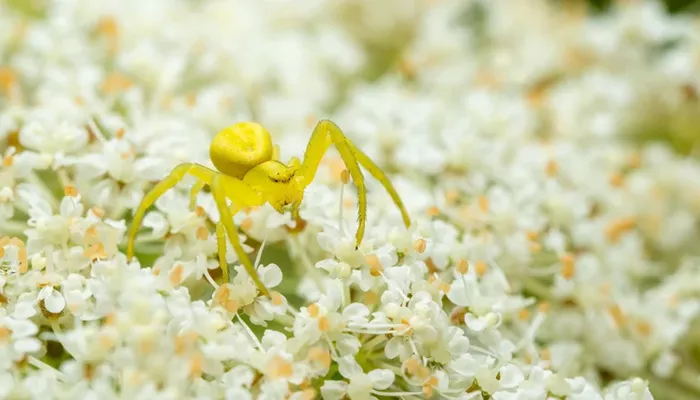Planting flowering perennials enhances your garden’s beauty and supports local wildlife. These vibrant blooms not only add visual appeal but also provide food for various insects. However, not all garden visitors are welcome, particularly the eight-legged kind. Crab spiders, for instance, can be unsettling. Their vibrant colors, such as yellow, help them blend into flowers, making them hard to spot. Gardeners who get close to popular blooms like roses, goldenrod, milkweed, daisies, and purple coneflowers might be surprised to find these stealthy spiders.
There are approximately 3,000 crab spider species globally, with a few hundred found in North America. These spiders, named for their crab-like sideways walk and long front legs, live in both wild areas and suburban gardens. They wait for insects to approach and then pounce, making them beneficial predators. Crab spiders also consume nectar and pollen, which is why they favor flowering plants over trees or grasses. Despite their venomous nature, which allows them to catch large insects relative to their size (0.2 to 0.5 inches), they rarely bite humans or pets and pose no significant threat.
Understanding the “Yellow Crab Spider”
The term “yellow crab spider” can be misleading. This name may refer to various crab spiders in the Thomisidae family, including species like Mecaphesa, Misumena, Misumenoides, and Misumessus. For example, the whitebanded crab spider (Misumenoides formosipes) is yellow with black and white stripes, while the goldenrod crab spider (Misumena vatia) often appears yellow but can change color to match its surroundings. This color change, which can take up to a month to complete, may help the spider camouflage itself to better hunt prey or evade predators.
Crab Spider Preferences
Crab spiders are often found on flowering plants, particularly those with yellow or white hues. They prefer certain plants over others. Goldenrod (Solidago species) is a favorite, so much so that one species is named after it. They also like milkweed, which they use for laying eggs; purple coneflowers (Echinacea purpurea); and various daisy-like plants, such as yellow corn daisy (Glebionis segetum) and ox-eye daisy (Leucanthemum vulgare).
Despite their preferences, crab spiders will inhabit nearly any flower, especially if it attracts insects. They are commonly seen on daisy fleabanes, snapdragons, Queen Anne’s lace, marigolds, sunflowers, black-eyed Susans, begonias, and yarrow. Uncommon hosts include Pequin peppers, water hemlock, St. John’s wort, and dogwood. In natural settings like prairies and meadows, they favor plants like wild bergamot and purple common mallow. Research suggests that color plays a role in the plant preferences of both crab spiders and their prey.
The Benefits of Crab Spiders
Although crab spiders do prey on pollinators, they also help control pest populations, such as grasshoppers and katydids. Studies indicate that plants hosting crab spiders often produce more seeds, benefiting gardeners. Some plants even release scents that attract crab spiders when under attack by pests, providing additional support to your garden. Therefore, rather than eliminating these spiders, consider enhancing your garden with a variety of flowering plants to support a healthy ecosystem.


